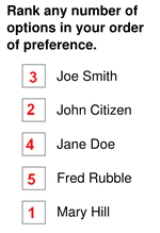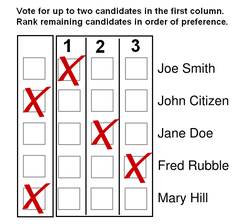
Preferential block voting
Encyclopedia
Preferential block voting is a majoritarian
voting system
for electing several representatives from a single multimember constituency. Unlike the single transferable vote
, preferential block voting is not a method for obtaining proportional representation
, and instead produces similar results to plurality block voting
, of which it can be seen as the instant-runoff
version. Under both systems, a single group of like-minded voters can win every seat, making both forms of block voting nonproportional.
Candidates with the smallest tally of first preference votes are eliminated (and their votes transferred as in instant runoff voting) until a candidate has more than half the vote. The count is repeated with the elected candidates removed and all votes returning to full value until the required number of candidates is elected. This is the method described in Robert's Rules of Order
for electing multiple candidates to the same type of office.
majorities for the group of candidates with the highest level of support. Under prefential block voting, a slate of clones of the first winning candidate are guaranteed to win every available seat. Although less representative, this does tend to lead to greater agreement among those elected.
from 1901 to 1948: from 1918, this was preferential block voting.
Majoritarian representation
A majoritarian voting system is an electoral method which gives the right to appoint all the representatives to the majority of the electors, denying representation to all minorities...
voting system
Voting system
A voting system or electoral system is a method by which voters make a choice between options, often in an election or on a policy referendum....
for electing several representatives from a single multimember constituency. Unlike the single transferable vote
Single transferable vote
The single transferable vote is a voting system designed to achieve proportional representation through preferential voting. Under STV, an elector's vote is initially allocated to his or her most preferred candidate, and then, after candidates have been either elected or eliminated, any surplus or...
, preferential block voting is not a method for obtaining proportional representation
Proportional representation
Proportional representation is a concept in voting systems used to elect an assembly or council. PR means that the number of seats won by a party or group of candidates is proportionate to the number of votes received. For example, under a PR voting system if 30% of voters support a particular...
, and instead produces similar results to plurality block voting
Plurality-at-large voting
Plurality-at-large voting is a non-proportional voting system for electing several representatives from a single multimember electoral district using a series of check boxes and tallying votes similar to a plurality election...
, of which it can be seen as the instant-runoff
Instant-runoff voting
Instant-runoff voting , also known as preferential voting, the alternative vote and ranked choice voting, is a voting system used to elect one winner. Voters rank candidates in order of preference, and their ballots are counted as one vote for their first choice candidate. If a candidate secures a...
version. Under both systems, a single group of like-minded voters can win every seat, making both forms of block voting nonproportional.
Casting and counting the ballots
In preferential block voting, a preference voting ballot is used, ranking candidates from most to least preferred. Alternate ballot forms may have two groupings of marks, first giving n votes for an n seat election (as in traditional bloc voting), but also allowing the alternate candidates to be ranked in order of preference and used if one or more first choices are eliminated.Candidates with the smallest tally of first preference votes are eliminated (and their votes transferred as in instant runoff voting) until a candidate has more than half the vote. The count is repeated with the elected candidates removed and all votes returning to full value until the required number of candidates is elected. This is the method described in Robert's Rules of Order
Robert's Rules of Order
Robert's Rules of Order is the short title of a book containing rules of order intended to be adopted as a parliamentary authority for use by a deliberative assembly written by Brig. Gen...
for electing multiple candidates to the same type of office.
Effects of preferential block voting
With or without a preferential element, block voting systems have a number of features which can make them unrepresentative of the diversity of voters' intentions. Block voting regularly produces complete landslideLandslide victory
In politics, a landslide victory is the victory of a candidate or political party by an overwhelming margin in an election...
majorities for the group of candidates with the highest level of support. Under prefential block voting, a slate of clones of the first winning candidate are guaranteed to win every available seat. Although less representative, this does tend to lead to greater agreement among those elected.
Usage of preferential block voting
Block voting was used in the Australian SenateAustralian Senate
The Senate is the upper house of the bicameral Parliament of Australia, the lower house being the House of Representatives. Senators are popularly elected under a system of proportional representation. Senators are elected for a term that is usually six years; after a double dissolution, however,...
from 1901 to 1948: from 1918, this was preferential block voting.
Ballots
| Rank ballot | Hybrid ballots | |
|---|---|---|
 |
 |
 |
| Three example ballots for a two-seat election, the first using a pure preference voting ballot, and the second using a plurality block voting ballot for the initial vote, and ranking only the alternate preferences. The hybrid ballots are intended to clarify the fact that the top n choices are counted simultaneously, and the ranked choices are used conditionally based on elimination. | ||

